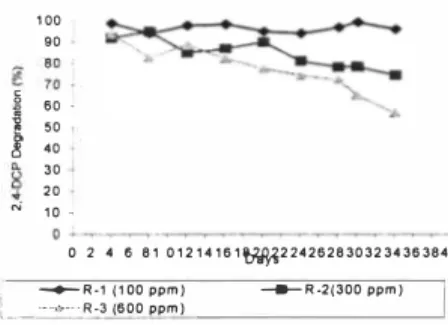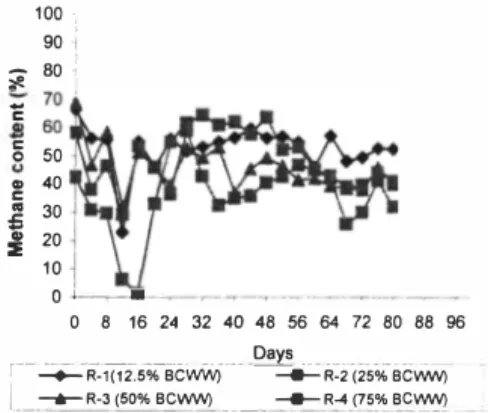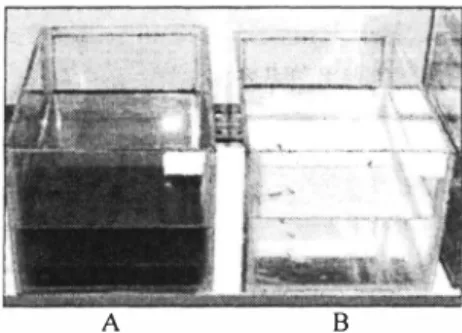Kalmar ECO-TECH '05 and
The Second Baltic Symposiwn on Environmental Chemistry KALMAR, SWEDEN, November 28-30, 2005
BIOREMEDIATION OF AOX FROM PULP
AND PAPER INDUSTRY WASTEWATER AND
AOX CONTAMINATED SOILS
N. S. Deshmukh
K. L. Lapsiya
D. V. Savant
A. M. Mujumdar
D.R. Ranade
Agharkar Research Institute, India
ABSTRACTBleaching of paper pulp with chlorine/ chlorine derivatives leads to formation of several organochlorine compounds. These compounds are collectively termed as "Adsorbable Organic Halides" (AOX). Toxic effects of AOX are well documented. Analysis of various wastewaters, soils irrigated with wastewater and sludge show significant levels of AOX. This is a potential threat to the environment. Physical and chemical methods of AOX removal are not economical. Hence, bioremediation technology needs to be developed for effective, ecofriendly and economical management of AOX containing waste. With this aim, anaerobic biofilm reactors (7.2L) were developed in our laboratory. Anaerobic cultures degrading chlorophenols were enriched and a consortium of such enrichments was used as the inoculum for the reactors. The reactors were fed with nutrient medium and run at 20 days HRT and at 30
°c.
Degradation of 2,4 dichlorophenol (2,4 DCP) was studied at 100 ppm, 300 ppm and 600 ppm and 96.7, 74.5 and 56.8 % dechlorination was observed, respectively. Anaerobic degradation at varying concentration of AOX from bleach composite wastewater (BCWW) was studied. Reactors fed with 12.5, 25, 50 and 75 % BCWW v/v showed 62.9, 56.5, 55.9 and 27.1% AOX degradation, respectively. The results suggest feasibility of treating the BCWW stream separately in anaerobic reactor and then mixing the effluent with composite wastewater. The treatment will ensure prevention of AOX pollution. Fish toxicity bioassays are being carried out to study safe disposal of treated wastewater in natural water bodies. Aerobic cultures degrading different chlorophenols were isolated. Using a consortium of these cultures bioremediation studies on AOX contaminated soils have been initiated.KEYWORDS
I. INTRODUCTION
In most of the developing countries, chlorine and chlorine derivatives are still used for bleaching of pulp. During conventional bleaching of pulp, chlorinated organic compounds are formed due to reaction with residual lignin. Around 500 different chlorinated compounds were identified including chlorinated phenols, catecols, guaiacols, furans, dioxins, syringols, chloroform, etc. [I, 2] Hence, amongst the different wastewater streams ofa pulp and paper (PAP) mill, bleach plant effluents are found to be most toxic. Chlorinated compounds are often mutagenic and carcinogenic to the biological systems. Production of I ton of pulp contributes about 2-4 kg of organochlorine compounds to the bleach plant effluents [3]. These are collectively called as Adsorbable organic Halides (AOX).
Increasing awareness of environmental impact of bleach effluent has lead to stringent regulations, particularly on AOX. Anaerobic dehalogenation is attracting great interest since it opens new research horizons based on the novel biochemical mechanisms i.e. dehalorespiration. Moreover, anaerobic process is more efficient than their aerobic counterpart in removing halogen atoms from polyhalogenated compounds [4, 5]. Besides these important properties, anaerobic treatment processes are economical relatively simple and inexpensive, consume little nutrients, produce less sludge and produce CH4 as an energy source. Considering this, we carried out studies on anaerobic degradation of AOX.
Treated effluent of pulp and paper mill is commonly used for irrigation [6]. As the treated effluent generally contains AOX, the soils so irrigated get contaminated with AOX [7, 8]. Similarly, sludge from the treatment plant also contains high amount of AOX [9]. It is necessary to remove AOX from such soil and sludge to avoid possible toxic effects. Bioremediation is a good method to achieve this.
2. MATERIALS AND METHODS 2.1. Enrichments
2.1.1. Anaerobic
Enrichments were developed for anaerobic dechlorinating bacteria using two nutrient media viz. BCYT medium [JO] and Freedman medium [l I] with some modifications. Anaerobic techniques developed by Ranade and Gadre [12] were followed. Inoculum sources included bleach composite wastewater, soil irrigated with pulp and paper industry wastewater, slurry of an anaerobic digester and river sediment. 2 chlorophenol (2 CP) was used as the test chloro compound at a concentration of2.5 - 25 ppm. Enrichments were incubated at 30 °C in dark. 2.1.2. Aerobic
Aerobic enrichments were set up using two media viz. Davis Mingiolis medium (DMM) and Freedman medium. Glucose ( 1.0 g/L) and acetate (5.0 g/L) were used as carbon source. pH was adjusted to 7.0. Soil irrigated with pulp and paper industry wastewater, treated wastewater and bleach composite wastewater were used as inocula. Different chlorophenols were added at
Kalmar ECO-TECH '05 and
The Second Baltic Symposium on Environmental Chemistry KALMAR, SWEDEN, November 28-30, 2005
concentrations ranging 2-30 ppm. The flasks were incubated at ambient temperature on a rotary shaker at 120 rpm. Enrichments were given transfer every 15 days. Degradation of chlorophenols was checked using HPLC. Dechlorinating bacteria were isolated using same nutrient media solidified with 3% w/v agar.
2.2. Biofilm Reactor Experiments
Anaerobic biofilm reactors (7.2L) fabricated in the laboratory and packed with Pall rings of uniform size were used. A consortium was prepared by mixing selected enrichments; effluent of the reactor previously fed with 2-CP and cattle dung and was used as the seed.
2.2.1. DCP Degradation
Three reactors viz. RI, R2 and R3 were spiked with 100 ppm, 300 ppm and 600 ppm 2,4 DCP, respectively. Degradation of 2,4 DCP and appearance of intermediates 2-chlorophenol and 4-chlorophenol was monitored using HPLC. Methane content was estimated by gas chromatography.
2.2.2. AOX Degradation
Degradation of AOX was studied in bleach composite wastewater (BCWW). Reactors RI, R2, R3 and R4 were run on 12.5%, 25 %, 50 % and 75% BCWW (v/v) diluted with water, respectively. pH was adjusted to 7.0 using NaOH. Nutrients were supplied in the form of Freedman medium. All the reactors were kept at 30 De and run at 20 days hydraulic retention time. AOX degradation and methane content were regularly monitored.
2.3. Bio remediation of soil
2.3.1. AOX degradation by indigenous microflora
As a prerequisite for bioremediation, an experiment was carried out to assess the dechlorinating activity of indigenous micro flora of soil. Glass bottles of 250 ml capacity were filled with I 00 g of soil which was irrigated by pulp and paper mill wastewater. Four sets of three bottles each, two (C and D) containing unsterile and two (A and B) containing sterile soil, were spiked with 50 ppm of 2,4 DCP. One set of unsterile (C) and sterile (A) b ottles were capped in order to determine the loss occurring due to evaporation and photodegradation. All the bottles were incubated at 30 De for 180 days. AOX was measured at the beginning and at the end of the experiment.
2.3.2. AOX degradation from BCWW
To assess the AOX degradation activity of aerobic isolates, an experiment was carried out. Selected isolates were grown in I 00 ml nutrient broth. Cell pellet obtained from freshly grown cultures after centrifugation at I 0,000 rpm for IO mins at 4 De was resuspended in saline, separately, to give final OD of 0.6 at 600 nm. BCWW diluted with tap water was used as test medium (20 % v/v). OAP (0.1%) was added as N and P source. The flasks were inoculated with culture suspension (IO % v/v). Control flasks contained I 00 ml of 20 % BCWW. The remaining culture suspensions of each isolate were mixed in equal proportion to form a consortium. This consortium was also inoculated to estimate combined degradation potential. One set of flasks was
inoculated with sterilized consortium. All flasks were incubated at ambient temperature on shaker at 120 rpm for 30 days, AOX content at the beginning and at the end of the incubation period were analyzed using AOX analyzer.
2.4. Toxicity bioassay
Toxicity of bleach composite wastewater and 2,4 DCP was assessed using fish. A 96 hrs acute toxicity test was carried out using guppy fish (Poecilia reticulata). Healthy fish of average weight 0.1-0.2 g and length 1-3 cm were acclimatized to laboratory conditions for 12 days, The fish were fed daily with fish food commercially available in the local market. The desired dissolved oxygen, pH, temperature and hardness were provided. During the experiments, seven fish were exposed to bleach composite wastewater and seven fish were kept in reconstituted fresh water as control. The fish were observed for mortality. A range finding test was performed for assessing toxicity of 2,4 DCP. In this experiment, 7 fish each were exposed to three concentrations ofa2,4 DCP viz. 0.625 ppm, 2.5 ppm and 10 ppm, One ml methanol was added to one tank as solvent control and the other control consisted of reconstituted fresh water.
2.5. Analytical methods
Chlorophenols were analyzed by HPLC (Dionex UK) with a reverse phase C18 column (LichroCART™ 4,6 mm x 250 mm, Merck Germany) mobile phase of methanol : water : acetic acid (60:38:2) and UV detector at 285nm wavelength [ 13]. Samples were first homogenized and mixed with equal volume of acetonitrile, They were centrifuged at I 0000 rpm for IO minutes at 4 �C. The supernatant was separated and used for analysis of chlorophenols,
Gas samples were analyzed by Gas Chromatograph (Chemito 3800) equipped with Thermal Conductivity Detector (TCD) and column Porapak Q at room temperature. Hydrogen was used as the carrier gas at a flow rate of 40 ml / min [ 12].
Samples of AOX were analyzed on AOX analyzer (Multi X 2000 Analytik Jena) by column method as per DIN 38409/14 standard. AOX of soil sample (IO g) was estimated using sludge head by batch method as per the instrument manual.
Fish toxicity bioassay was carried out according to guidelines provided by Standard Methods (14].
3. RESULTS AND DISCUSSIONS 3.1. Enrichments
3.I. I. Anaerobic
Anaerobic degradation of 2 CP in enrichment cultures was achieved successfully in 30-120 days. The range of 2 CP degradation was 68 to 94 %. It was observed that time required for 2-CP degradation varied with inoculum.
90 Kalmar ECO-TECH '05 and
The Second Baltic Symposium on Environmental Chemistry KALMAR, SWEDEN, November 28-30, 2005 3.1.2. Aerobic
Aerobic degradation of 2 CP , 3 CP and 4 C P was achieved successfully. After success of enrichment as was seen by degradation of organochlorines, isolation was carried out. A total number of 7 aerobic isolates were obtained. The isolates were assessed for degradation potential. Out of seven isolates El-I, El-2 and E9-I showed 65.43, 72.00 and 62.66% 2 CP degradation and hence were selected for further study.
3.2. Biofilm Reactor Experiments 3.2.I. DCP Degradation
Degradation of 2,4 DCP at varying concentration in the anaerobic biofilm reactors was studied. In this experiment transformation of 2,4-DCP to 4-CP and 2-CP was observed. The average dechlorination in the R-1 (100 ppm), R-2 (300 ppm) and R-3 (600 ppm) reactors was 96.7, 74.5 and 56.8% (Figure 1), respectively, with 63.3, 62.0 and 33.0% methane content in biogas
produced (Figure 2), respectively. Thus, degradation of 2,4 DCP was efficient up to 300 ppm
concentration. At higher concentration of 600 ppm, there was a significant drop in 2,4 DCP degradation and was toxic to methanogenic activity.
100 100 i 80 90 � 60 • 50 40
i
30 20 N 10 � 0 2 4 6 81 01214161t,?Jyi2242628303234363840 - -+-R-1 (100 ppm) �R-2(300 ppm) [__� --w•·-·R-3 (600 ppm)Figure 1. 2,4 DCP degradation at different Concentrations. 3.2.2 AOX Degradation - 70 60 =8! 50 !! 40
I ��
J
»--.. \."
10 1 0 .)_,_ �':.:-.:;.._":..,.� 0 4 8 12 16 20 24 28 32 36 40 44 48 Days [�11oo_�_p_m) :._.._ (300 ppm) ---:��o�.!'J'"cl]Figure 2. Methane content in biogas at different concentrations of 2, 4 DCP.
The average AOX degradation in reactor R-1, R-2, R-3 and R-4 were 56.6%, 49.5%, 48.5% and 14.4 % (Figure 3), respectively and average methane content in biogas was 52%, 41.3%, 46.0% and 44.2 % (Figure 4), respectively. The degradation pattern clearly indicates possibility of developing the anaerobic biofilm reactor for treatment of AOX.
I --.-..r.r t..J.l 100 100 -, 00 0 9 I Ill I - 80, 'ii',
"'
" 70. O -� 00! CI
� 50�l5
50l
«>J ''\ .... f
a, 40 0;S
C 30. .,�-.. t:lY!_
<( al i 10' j 20ohoooooooooo
10 8 IB � � «> � � � n Ill QI •�
0 8 16 24 32 40 48 56 64 72 80 88 961
-+-R-1(12s%1Dl'Ml -tt-R-2(25"/o!D/'Ml ,, ---·--·--- ______Da�s _______________ __ --R-1(12.5% BCWW) --R-2 (25% BCVVW) ! -+-R-3 (00'/o!D/'Ml --+E-R4(75%1D/'Ml L - ·-·- ---I.__
--R-3(50% BCWW) _____ --R-4(75% BCVVW) gFiure 3. AOX degradation at different Figure 4. Methane content in biogas at
concentrations of BCWW. different concentrations of BCWW.
3.3 Bioremediation of soil
3.3.1 AOX degradation by indigenous microtlora:
The results (Figure 5) show that rate of degradation of AOX in nonsterile and sterile soil sets is
comparable. In sets C and D AOX degradation is 38.46 % and 23.07 %, respectively. This difference in degradation is due to availability of air for set D. AOX degradation in case of sets A and B is same, 8.3%. This loss may be due to photodegradation.
A B C D
Figure 5. AOX degradation in soil. 14 12
j
1D 8 6 4 [:�� a �ay:;
2 0Kalmar ECO-TECH '05 and
The Second Baltic Symposiwn on Environmental Chemistry KALMAR, SWEDEN, November 28-30, 2005
3.3.2. AOX degradation from BCWW
From the results (Figure 6) of AOX analysis it is seen that consortium could degrade maximum AOX, i.e., 20.37%, followed by El-I which could degrade 15.25% AOX. Also, it is seen that reduction in AOX level is due to degradation and not due to adsorption on cells as there is no reduction in AOX level in flasks inoculated with autoclaved consortium, This shows the possibility of use of aerobic consortium for bioremediation of soil contaminated with AOX.
Figure 6. Degradation of AOXfrom BCWW
3.4. Toxicity bioassay
It was observed that all the fish exposed to bleach composite wastewater died within 24 hrs, On the other hand, fish in the control survived all 4 days (Figure 7). Thus, it was concluded that the bleach waste was highly toxic to fish.
A B
KALMAR, SWEDEN, November 28-30, 2005
In the other experiment, it was observed that all the fish in methanol control, 0.625 ppm, 2.5 ppm and fresh water control survived. However fish exposed to IO ppm 2,4 DCP died within half an hour's exposure indicating toxicity of 2,4 DCP.
It should be noted that during the biofilm reactor experiment with I 00 ppm 2,4 DCP, the residual organochlorine was around 2.5 ppm (Figure I ), a concentration which is proved non-toxic during fish experiment. Thus, it can be said that anaerobic treatment is efficient in removing toxicity of a pure chlorinated compound upto I O0ppm concentration. Experiments on anaerobic treatment of Bleach composite wastewater are in progress.
ACKNOWLEDGEMENTS
We thank the Swedish International Development Agency, Sweden, and Asian Institute of
Technology, Thailand, for financial support for the study.
REFERENCES
[ I ) Freire, C. S. R., Silvestre, A. J. P., Neto, C. P., 2003. Carbohydrate derived chlorinated compounds in ECF bleaching of hardwood pulp: formation, degradation and contribution to
AOX in a bleached Kraft pulp mill. Environmental Science and Technology 37, 8 1 1 -8 1 4.
[2) Suntio, L. R., Shiu, W. Y., MacKay, D. A., 1 988. A review of the nature and properties of the chemicals present in pulp and paper mill effluents. Chemosphere 17 (7), 1249-1 290.
[3) Bajpai, P., 2001. Microbial degradation of pollutants in pulp mill effluents. Advances in
Applied Microbiology 48, 79- 134.
[4] Fantroussi, El. S., Naveau, H., Agathos, S. N., 1998. Anaerobic dechlorinating bacteria.
Biotechnology progress 14, 167-188.
[5] Mohn, W. W., Tiedje, J. M., 1992. Microbial reductive dehalogenation. Microbiology
Reviews 56, 482-484.
[6] Dutta, S. K., Boissya, C. L., 1 996. Effect of paper mill effluent on germination of rice seed
(Oryza saliva L. Var MASURJ) and growth behavior of its seedlings. Journal of Industrial Pollution Control 1 2 (2), 1 23- 1 28.
[7] Palm, H, Lammi, R., I 995. Fate of pulp mill organochlorines in the Gulf of Bothnia sediments. Environmental Science and Technology 29, 1722-1727.
[8) Malla, L., Mohanty, B. K., 2005. Effect of paper mill effluent on germination of green gram
(Phaseolus aureus Roxb.) and growth behavior of its seedlings. Journal of Environmental Biology 26(2 suppl), 379-382.
[9) Welker, A., Schmitt, T. G., 1 997. A basic investigation in origins of AOX- substances in paper sludges. Water Research 3 1 (4), 805-8 I 5.
[10) Touzel, J.rP., Albagnac, G., 1983. Isolation and characterization of Methanococcus mazei strain MC3. FEMS Microbiology Letters 16, 241-245.
[I 1 ) Freedman, D. L., Gossett, J. M., 1 989. Biological reductive dechlorination of tetrachloroethylene and trichloroethylene to ethylene under methanogenic conditions. Applied and Environmental Microbiology 55 (9), 2 144-2 1 5 1 .
[13]
Kalmar ECO-TECH '05 and
The Second Baltic Symposiwn on Environmental Chemistry
KALMAR, SWEDEN, November 28-30, 2005
[ 1 2] Ranade, D, R,, Gadre, R, V,, 1988, Principles of anaerobic techniques and culture methods. In: Ranade and Gadre (ed.), Microbiological Aspects of Anaerobic Digestion: Laboratory Manual. Published by MACS Research Institute, Pune, India, 15-30.
Becker, J. G., I 999. Reductive dehalogenation and conversion of 2-chlorophenol to 3-chlorobenzoate in methanogenic sediment community. Applied and Environmental
Microbiology 65 ( 11 ), 5169-5172.
[r1 4] Greenberg, A. E., Clesceri, L, S,, Eaton, A. D., 1992, Standard methods for examination of water and wastewater. ( I 8th Ed.). APHA, A WWA and WPCF, Washington DC.


